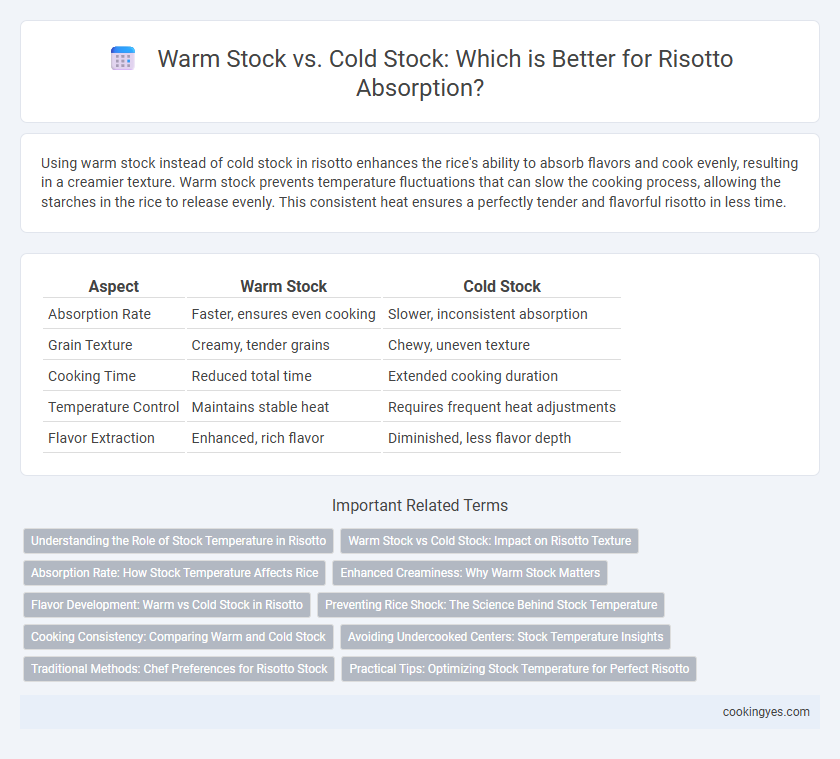Using warm stock instead of cold stock in risotto enhances the rice's ability to absorb flavors and cook evenly, resulting in a creamier texture. Warm stock prevents temperature fluctuations that can slow the cooking process, allowing the starches in the rice to release evenly. This consistent heat ensures a perfectly tender and flavorful risotto in less time.
Table of Comparison
| Aspect | Warm Stock | Cold Stock |
|---|---|---|
| Absorption Rate | Faster, ensures even cooking | Slower, inconsistent absorption |
| Grain Texture | Creamy, tender grains | Chewy, uneven texture |
| Cooking Time | Reduced total time | Extended cooking duration |
| Temperature Control | Maintains stable heat | Requires frequent heat adjustments |
| Flavor Extraction | Enhanced, rich flavor | Diminished, less flavor depth |
Understanding the Role of Stock Temperature in Risotto
Warm stock promotes even absorption and consistent texture in risotto by maintaining a steady cooking temperature, preventing the rice from cooling down and prolonging cooking time. Cold stock causes temperature fluctuations, leading to uneven starch release and a less creamy result. Properly heated stock enhances the risotto's creamy texture and cooking efficiency by optimizing the rice's ability to absorb liquids smoothly.
Warm Stock vs Cold Stock: Impact on Risotto Texture
Warm stock enhances risotto texture by promoting even starch release and consistent rice absorption, resulting in a creamy and cohesive dish. Cold stock cools the cooking surface intermittently, causing uneven starch gelatinization and potentially a grainy or clumpy texture. Maintaining warm stock throughout the cooking process ensures optimal moisture retention and the rich, velvety mouthfeel characteristic of classic risotto.
Absorption Rate: How Stock Temperature Affects Rice
Warm stock enhances the absorption rate in risotto by allowing the rice to cook evenly and absorb flavors more efficiently, leading to a creamier texture. Cold stock lowers the temperature in the pot, slowing the cooking process and causing uneven absorption, which can result in undercooked grains. Maintaining stock at a simmering temperature around 85-90degC optimizes starch release from Arborio or Carnaroli rice, essential for the signature creamy consistency of authentic risotto.
Enhanced Creaminess: Why Warm Stock Matters
Using warm stock in risotto significantly improves starch absorption from the arborio rice, resulting in a creamier texture. Cold stock slows the cooking process, causing uneven starch release and a less velvety consistency. Maintaining consistent temperature with warm stock ensures optimal starch gelatinization, enhancing the risotto's signature creaminess.
Flavor Development: Warm vs Cold Stock in Risotto
Using warm stock instead of cold stock in risotto enhances flavor absorption by maintaining a consistent cooking temperature, which allows the rice to release starch evenly and soak up the broth's rich, savory notes. Warm stock accelerates the integration of ingredients, intensifying the taste and creating a creamy texture typical of classic risotto. Cold stock can slow down the cooking process, diluting flavor development and resulting in a less cohesive dish.
Preventing Rice Shock: The Science Behind Stock Temperature
Warm stock is essential for optimal rice absorption during risotto preparation because it prevents rice shock, a phenomenon where cold stock causes the starch granules to contract suddenly. This contraction slows down the gradual release of starch, resulting in uneven cooking and a less creamy texture. Maintaining stock at a consistent warm temperature ensures smooth starch gelatinization, yielding the hallmark creamy and velvety risotto texture.
Cooking Consistency: Comparing Warm and Cold Stock
Using warm stock in risotto cooking enhances starch absorption and promotes a consistent, creamy texture by maintaining a steady temperature throughout the cooking process. Cold stock slows the heating cycle, causing uneven starch release and potentially resulting in a less smooth, unevenly cooked dish. Professional chefs prefer warm stock to ensure optimal grain swelling and uniform creaminess essential for authentic risotto consistency.
Avoiding Undercooked Centers: Stock Temperature Insights
Warm stock promotes even absorption in risotto, preventing undercooked centers by maintaining consistent heat during cooking. Cold stock lowers the overall temperature, leading to uneven cooking and a higher risk of hard, undercooked grains. Optimal risotto texture relies on using warm stock to ensure thorough, uniform starch release and creamy consistency.
Traditional Methods: Chef Preferences for Risotto Stock
Traditional chefs prefer warm stock over cold stock for risotto because warm stock ensures consistent absorption and prevents temperature shocks that can hinder the rice's creamy texture. Maintaining the stock at a simmer allows the Arborio or Carnaroli rice to release starch evenly, creating the signature velvety consistency of classic risotto. Using cold stock can slow the cooking process and result in uneven texture, reducing the dish's overall quality.
Practical Tips: Optimizing Stock Temperature for Perfect Risotto
Using warm stock instead of cold stock is crucial for achieving the ideal creamy texture in risotto because it maintains a consistent cooking temperature, ensuring even absorption by the Arborio rice. Cold stock lowers the pan's temperature, causing uneven cooking and prolonged cooking time, which can lead to a mushy or undercooked risotto. To optimize stock temperature, keep the broth simmering on low heat and add it gradually in warm increments, allowing the rice to release its starch properly for that signature velvety consistency.
Warm stock vs Cold stock for absorption Infographic

 cookingyes.com
cookingyes.com